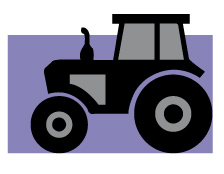January 2020
| Written by a retired farmer |  |
The expression ‘top dressing or side dressing’ refers to the generally accepted farming practice of applying extra fertilisation to a field crop after emergence. The main nutrient supplied in addition to the fertiliser applied before or at planting will be nitrogen. Only nitrogen or a combination of nitrogen and other nutrients can be applied by side dressing on top of the soil or by tynes in the soil between the rows.
This application usually might occur only once after planting and emergence in dryland maize and other row crops. Usually several applications of nitrogen, in the form of dissolved urea, are given to high yielding maize crops under centre-pivot and other irrigation systems.
When the crop is too tall for the fertiliser to be applied by tractor, a proper ‘top dressing’ would be required if there are concerns of nitrogen leaching having occurred through excess rains or irrigation. The introduction of modern high reaching dedicated tractors and equipment have allowed farmers to apply the fertiliser at later growth stages if required.
Although this article concentrates on maize production, nutrient application can be done on all other grain row crops if required. The nutrients can be applied in granular or liquid form and might also form part of a package of soil applied nutrients as well as foliar spray on the plant leaves to apply the needed shortfall of micronutrients. This is usually decided after a comprehensive sampling of the leaves at certain growth stages.
MAIZE FERTILISATION IN GENERAL
It is assumed that you have had your soils properly tested and have done soil profiles on all lands to be planted to maize. If you have developed a relationship with a reliable fertiliser supplier you can work together over several crops to fine tune the application of enough main and micro nutrients to reach the attainable yield targets indicated by soil depth, existing soil fertility, planting date, cultivar choice and climate together with rainfall patterns occurring on your farm.
It is essential to optimally fertilise lands to their practical potential as the costs of production to income are progressively becoming tighter.
You can safely budget on a total of 25 kg of nitrogen per ton of maize produced per hectare. This allows for both vegetative growth and the grain fill required to achieve the targeted yield. Thus, a 3 t/ha yield target implies an application of a minimum of 75 kg of nitrogen at planting or split between planting and a side or top dressing. A 4 t/ha crop would require 100 kgs of nitrogen/ha. At the top end an 8 t/ha yield target would thus require 200 kg of nitrogen per hectare. These amounts applied all at planting can cause seedling emergence damage and cannot be placed with or too close to the seed kernels being planted. It is advisable to do a side or top dressing in these cases. Remember we are considering, in the discussion above, just the nitrogen required in kg/ha, not the total mixture.
Please consult with your fertiliser supplier or production consultant as to the overall application of fertiliser mixes, whether in granular or liquid form, required for a determined yield target. There are many fertiliser mixes, some also including sulphur and lime (to reduce acidity), on the market.
At a minimum the nitrogen, phosphate and potassium applications in kg/ton of seed/ha shown below should be applied at planting or at planting and side dressing using the guidelines in Table 1.

Past experience has shown that many crops exhibiting nitrogen shortages in fact have a shortage of sulphur. This can be determined by observation and leaf analysis.
Side dressing with just urea or UAS which is a combination of urea and ammonium sulphate is highly recommended.
Some farmers have started the practice of applying a broadcast application of all the fertiliser requirements on the lands prior to planting. This can be combined with side placing of additional or a planned amount of nitrogen later. This practice avoids the possibility of not being able to apply the critical planned side dressing in very wet years.
TIMING OF THE APPLICATION OF SIDE OR TOP DRESSING
Maize takes up about half of its required nitrogen from the soil between the vegetative growth stages V8 to VT. These stages can occur between 32 days to 56 days after the seedlings have emerged. Please find or look at a chart of the growth phases if you have never seen one. The ideal period to apply the side dressing of nitrogen is thus a window of only about 24 to 30 days. If high rainfall on the crop after emergence is experienced more nitrogen than originally planned might have to be applied as soon as the tractors and equipment can work in the lands.
CONCLUSION
Careful planning for the optimum total fertilisation and especially nitrogen requirements of your crop must be undertaken prior to the planting season. The correct use of the combination of tractors and side dressing equipment that you already own will determine the best path for success.
Publication: January 2020
Section: Pula/Imvula